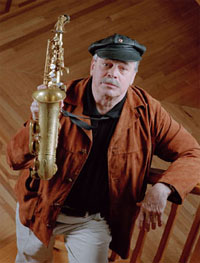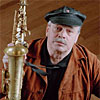
Phil Woods is a band guy deep down. Though he has recorded hundreds of small-group albums, Phil always sounds most at home standing out in a crowd. Interestingly, his first commercial recording was with Neal Hefti and His Orchestra (Hot 'N Hearty in 1955), and some of his most memorable recordings have been as the soulful soloist on recordings by superb orchestras: Larry Sonn's The Sound of Sonn (1955), Dizzy Gillespie's World Statesman (1956), Manny Albam's Jazz Greats of Our Time Vol. 2 and The Blues Is Everybody's Business (1957), Michel Legrand's Legrand Jazz (1958), Gene Krupa Plays Gerry Mulligan (1958), Bill Potts's The Jazz Soul of Porgy & Bess (1959) and Quincy Jones and His Orchestra from 1959 into the early '60s.
So it's gratifying to hear Phil once again with a bright, polite band. His latest album, Right to Swing: Phil Woods with the DePaul University Jazz Ensemble (Jazzed Media) directed by Bob Lark, features Phil comfortable swimming with sharks. The album's first five tracks were arranged by Phil while the final five were handled by Phil and several students. All of the songs were written by Phil.
Phil loves working with DePaul University in Chicago. He has donated much of his 300 original compositions to the college. And it's no wonder. The musicians on his recordings with DePaul ensembles are superb and have terrific taste and judgment. Phil's close ties to the school has much to do with Lark [pictured above], who is director of jazz studies and teaches jazz trumpet and jazz pedagogy and jazz style.
On Right to Swing, there's no wheel-spinning or attempts to sound like fusion-crazed teens. Songs and arrangements are economical and hearken back to a time when jazz-band recordings breathed, climbed dramatically and moved toward a goal. Weak End, arranged by Carl Kennedy, is a perfect example. A mid-tempo swinger, the song features Phil and trumpeter David Kaiser soloing. The band slides in and out with airy bounce and tonal intelligence. What a rare joy to hear a band that does not succumb to section yammering and showcasing. Every bit of music here has purpose and united execution.
Or Cormac McCarthy's stealthy and cinematic arrangement of Phil's Casanova. There's plenty of drama and technique in the solos by Phil and vibraphonist David Bugher. You can almost hear Phil listening intently and being motivated by the warm textures behind him. There's a lot of color here and uplifting supported by the band. Dig Phil's reedy arrangement of his Scherzo.
If this CD is any indication, Phil is on top of his game at age 81—never relying on cliches or time-worn tricks. With a band this good, Phil has no choice but to show his stuff and exhibit the sound and fifth-gear energy that made him the go-to East Coast alto soloist throughout the '50s. Now, more than 50 years later, he's once again in the thick of a band, soaring away. I'd add this album to the collection of must-haves mentioned above. And that's saying something. [Pictured above: Phil Woods in 1956]
JazzWax tracks: You'll find Right to Swing: Phil Woodswith the DePaul University Jazz Ensemble (Jazzed Media) here.
JazzWax tracks: You'll find Right to Swing: Phil Woods
This story appears courtesy of JazzWax by Marc Myers.
Copyright © 2024. All rights reserved.



























